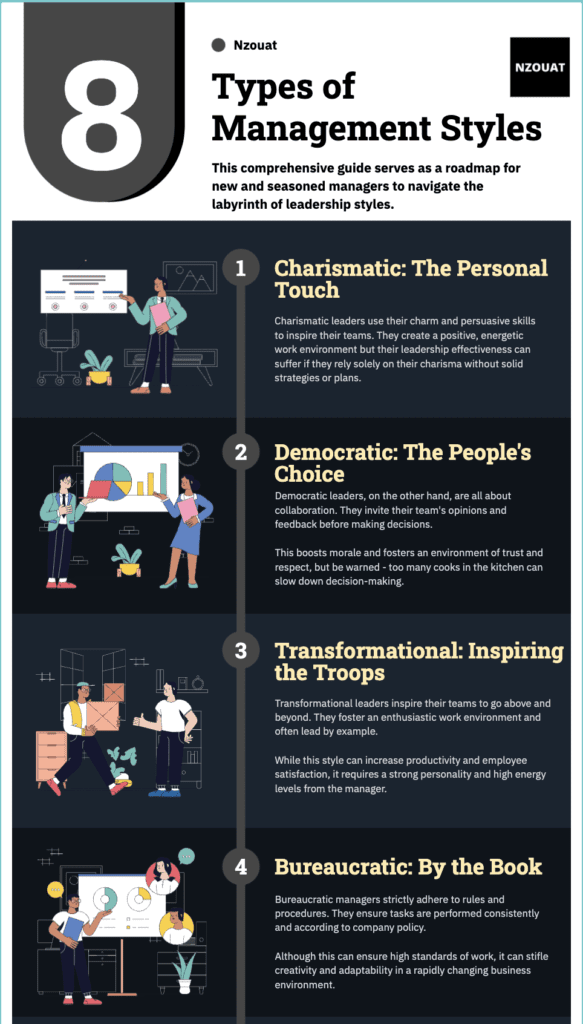The Art of Leadership
Leadership, you’ve got to admit, is a pretty tricky business. It’s more than just bossing people around. It’s about guiding, inspiring, and getting the best out of your team. That’s where different management styles come into play. Like a seasoned chef, a great leader knows when to sprinkle a bit of autocratic decision-making, or perhaps a pinch of democratic participation, to whip up the perfect leadership dish.
Get ready, because we’re about to delve into the “8 Types of Management Styles” – the secret ingredients to becoming an exceptional leader.
8 Types of Management Styles: Your Leadership Compass
Here’s a heads up – there’s no one-size-fits-all approach when it comes to leadership. Different situations call for different management styles, and the trick is to know when to employ which. So, buckle up as we unravel these eight styles one by one.
Autocratic: The One-Man Show
Autocratic managers hold the reins tight. They make decisions independently with little or no input from their team. This style is effective in high-pressure situations where quick decisions are needed, but beware, it can stifle creativity and employee morale if used excessively.
Democratic: The People’s Choice
Democratic leaders, on the other hand, are all about collaboration. They invite their team’s opinions and feedback before making decisions. This boosts morale and fosters an environment of trust and respect, but be warned – too many cooks in the kitchen can slow down decision-making.
Laissez-faire: Free as a Bird
Under the laissez-faire style, managers give their teams plenty of autonomy. They trust their employees to perform their tasks without constant oversight. While this can promote innovation and job satisfaction, a lack of direction can lead to chaos if not managed properly.
Transactional: You Scratch My Back, I’ll Scratch Yours
Transactional managers operate on a reward-and-punishment system. They set clear expectations and employees are rewarded or penalized based on their performance. This can drive productivity, but over-reliance on extrinsic motivation might neglect the intrinsic motivation that sparks creativity.

Transformational: Inspiring the Troops
Transformational leaders inspire their teams to go above and beyond. They foster an enthusiastic work environment and often lead by example. While this style can increase productivity and employee satisfaction, it requires a strong personality and high energy levels from the manager.
Servant: Putting Others First
A servant leader prioritizes the needs of the team above their own. They focus on employee growth and well-being, which can lead to high morale and productivity. However, this style may face challenges in hierarchical organizations where top-down leadership is the norm.
Bureaucratic: By the Book
Bureaucratic managers strictly adhere to rules and procedures. They ensure tasks are performed consistently and according to company policy. Although this can ensure high standards of work, it can stifle creativity and adaptability in a rapidly changing business environment.
Charismatic: The Personal Touch
Charismatic leaders use their charm and persuasive skills to inspire their teams. They create a positive, energetic work environment but their leadership effectiveness can suffer if they rely solely on their charisma without solid strategies or plans.

Choosing Your Management Style: A Comparative Analysis
When it comes to choosing your management style, it’s all about understanding the trade-offs. Here’s a quick comparative analysis of the strengths and weaknesses of each style:
| Management Style | Strengths | Weaknesses |
|---|---|---|
| Autocratic | Quick decision-making, Effective in high-pressure situations | Can stifle creativity, May reduce employee morale |
| Democratic | Promotes collaboration, Boosts morale | Can slow down decision-making |
| Laissez-faire | Promotes innovation, Can boost job satisfaction | Lack of direction can lead to chaos |
| Transactional | Drives productivity, Clear expectations | Over-reliance on extrinsic motivation can neglect creativity |
| Transformational | Increases productivity, Can boost employee satisfaction | Requires high energy levels, Needs strong personality |
| Servant | Prioritizes team needs, Can lead to high morale and productivity | May face challenges in hierarchical organizations |
| Bureaucratic | Ensures high standards of work, Follows rules strictly | Can stifle creativity, May hinder adaptability |
| Charismatic | Inspires team, Creates positive work environment | Reliance on charisma without strategies can be ineffective |
Remember, you don’t have to pick just one. The most effective leaders are those who can fluidly switch between different “8 Types of Management Styles” depending on the situation.
Frequently Asked Questions (FAQs) About Management Styles
What are the “8 Types of Management Styles”?
The “8 Types of Management Styles” are Autocratic, Democratic, Laissez-faire, Transactional, Transformational, Servant, Bureaucratic, and Charismatic.
Which management style is the best?
There isn’t a “best” management style. The effectiveness of a style depends on the situation, team dynamics, and individual personalities. The key is to be adaptable and use the right style at the right time.
Can a manager have more than one management style?
Absolutely! In fact, the best managers often switch between different management styles depending on the situation.
How do I choose my management style?
Choosing a management style isn’t a one-time decision. It’s a dynamic process that requires self-awareness, understanding of your team, and adaptability to different situations.
Can my management style evolve over time?
Yes, and it should! As you gain more experience, receive feedback, and learn more about your team, your management style should evolve to become more effective.
How can I improve my management style?
Improving your management style involves continuous learning and feedback. It can include training, mentoring, reading about leadership theories, and most importantly, being open to feedback from your team.
Conclusion: Mastering the Symphony of Leadership
Understanding and navigating the “8 Types of Management Styles” is like conducting a symphony. It requires the ability to bring together different instruments (or in this case, styles) to create a harmonious performance.
